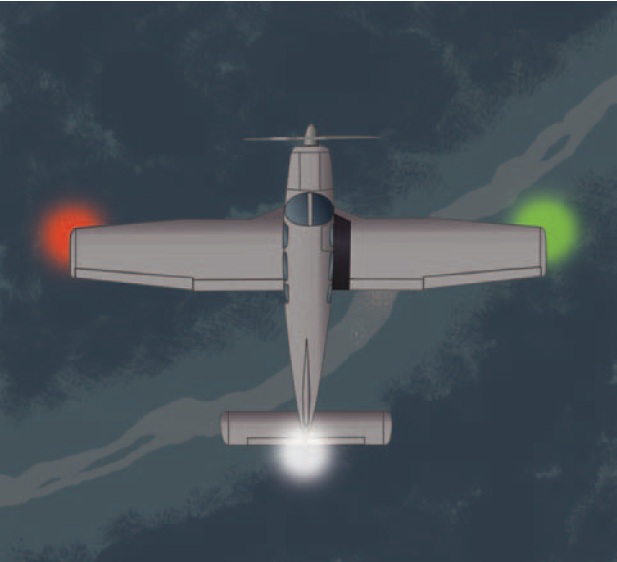
Chapter 10 Night Operations
Night Vision
Night Illusions
Pilot Equipment
Airplane Equipment and Lighting
Airport and Navigation Lighting Aids
Preparation and Preflight
Starting, Taxiing, and Runup
Takeoff and Climb
Orientation and Navigation
Approaches and Landings
Night Emergencies
Table of Contents

AIRPLANE EQUIPMENT AND LIGHTING
Title 14 of the Code of Federal Regulations (14 CFR) part 91 specifies the basic minimum airplane equipment required for night flight. This equipment includes only basic instruments, lights, electrical energy source, and spare fuses.
The standard instruments required for instrument flight under 14 CFR part 91 are a valuable asset for aircraft control at night. An anticollision light system, including a flashing or rotating beacon and position lights, is required airplane equipment. Airplane position lights are arranged similar to those of boats and ships. A red light is positioned on the left wingtip, a green light on the right wingtip, and a white light on the tail. [Figure 10-2]

Figure 10-2. Position lights.
This arrangement provides a means by which pilots can determine the general direction of movement of other airplanes in flight. If both a red and green light of another aircraft were observed, the airplane would be flying toward the pilot, and could be on a collision course.
Landing lights are not only useful for taxi, takeoffs, and landings, but also provide a means by which airplanes can be seen at night by other pilots. The Federal Aviation Administration (FAA) has initiated a voluntary pilot safety program called “Operation Lights ON.” The “lights on” idea is to enhance the “see and be seen” concept of averting collisions both in the air and on the ground, and to reduce the potential for bird strikes. Pilots are encouraged to turn on their landing lights when operating within 10 miles of an airport. This is for both day and night, or in conditions of reduced visibility. This should also be done in areas where flocks of birds may be expected.
Although turning on aircraft lights supports the see and be seen concept, pilots should not become complacent about keeping a sharp lookout for other aircraft. Most aircraft lights blend in with the stars or the lights of the cities at night and go unnoticed unless a conscious effort is made to distinguish them from other lights.
Ch 10.qxd 7/13/04 11:10 AM Page 10-4PED Publication